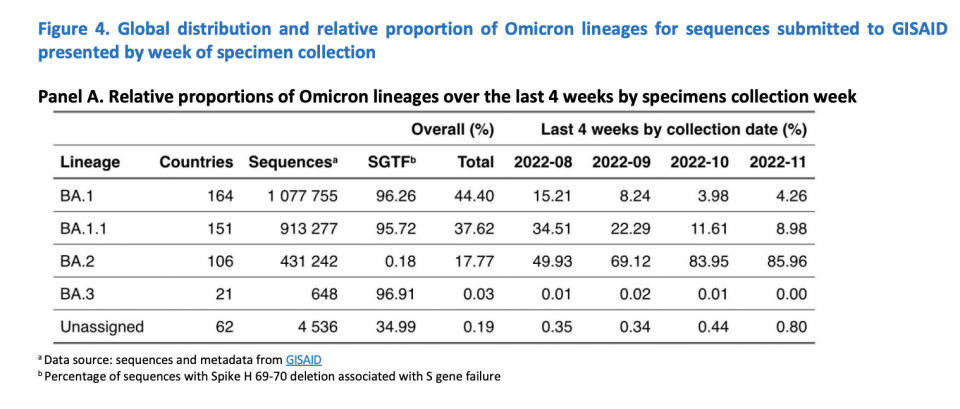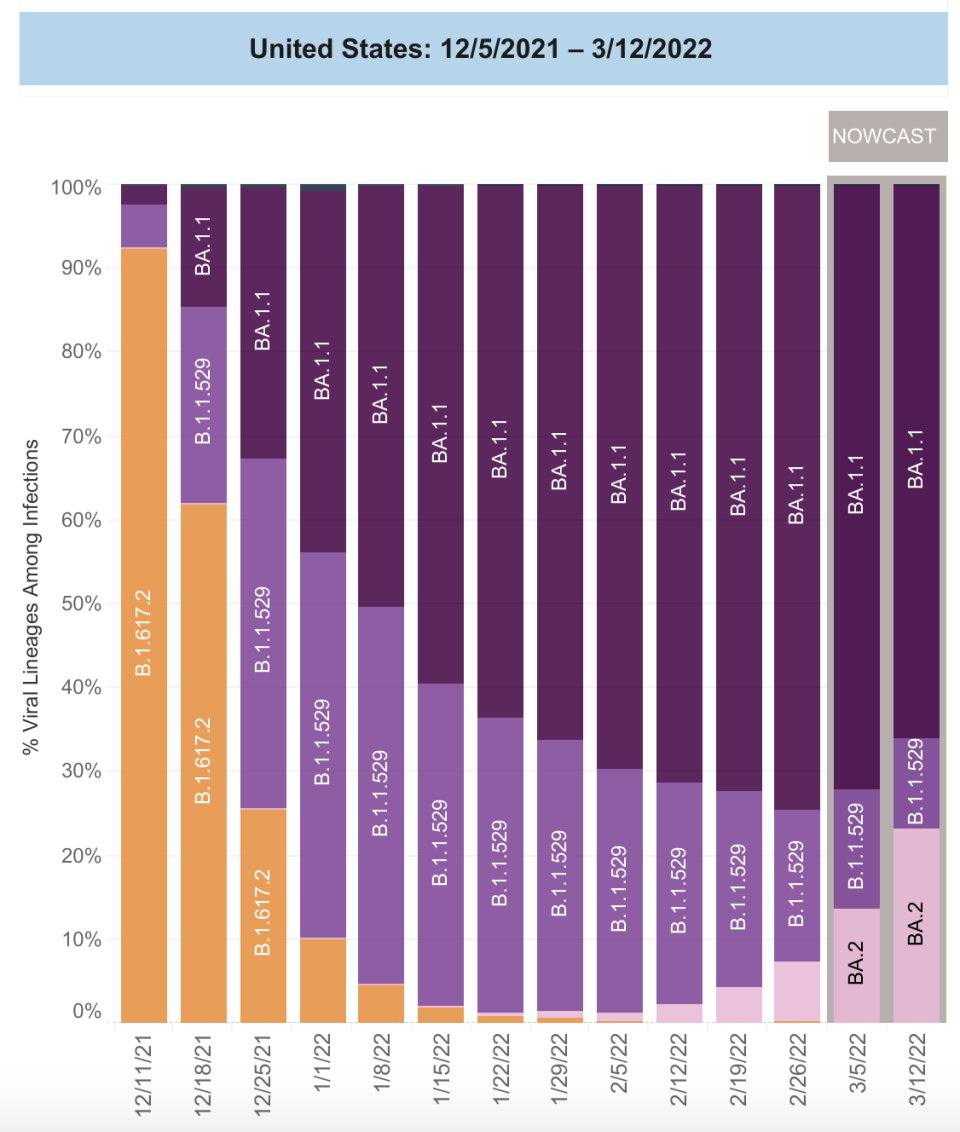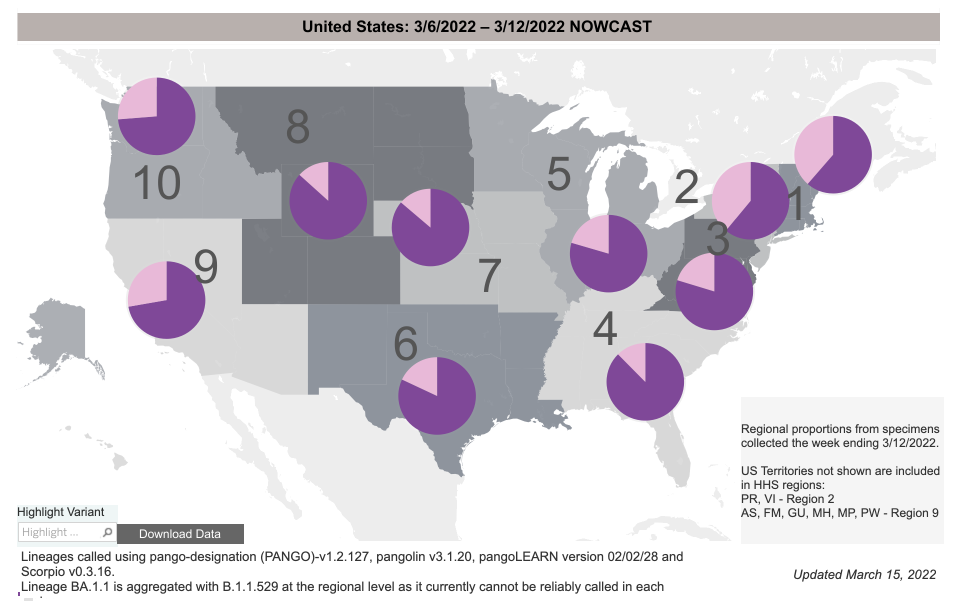More Transmissible BA.2 Omicron Variant Achieves Global Domination: Now Accounts For About 85% Of Covid Cases Sequenced Worldwide, Per WHO – Update

UPDATED with latest: One week after the World Health Organization reported that the BA.2 Omicron variant had become the dominant strain globally, accounting for 75% of new cases sequenced, the U.N. body is reporting that dominance has risen to 85.96%. The original Omicron variant, dubbed BA.1, has shrunken to just over 4% of cases. A third strain of Omicron, BA.1.1, is at about 9%.

More from Deadline
Omicron BA.2 Variant Now More Than Half Of All New Covid Cases Across Large Swath In U.S., Per CDC
Hillary Clinton Tests Positive For Covid, Says She's "More Grateful Than Ever" For Vaccines
White House Press Secretary Jen Psaki Said She Tested Positive For Covid
BA.2 is thought to be about 30% more transmissible than BA.1, which itself was more transmissible than Delta. This is one explanation for BA.2’s ascendancy. It’s also thought to be a cause of skyrocketing cases in the U.K., Austria and Switzerland. According to WHO, 10 countries in Europe reported increases in new cases of 20% or greater this week.
The 7-day average number of new cases in the U.K. has more than doubled since February 25, from a little over 33,000 to just under 80,000, per Johns Hopkins University. Over roughly the same period, incidence of BA.2 in U.K. cases sequenced rose from 33% to 85%.
The United States is doing better, with new cases down 3% in the past week, per the New York Times, and BA.2 accounting for a far smaller portion of the cases sequenced. Numbers released this morning by the CDC indicate that the percentage of new Covid cases across the United States tied to the even more transmissible variant has jumped from 23% in early March to 35% this week.
Regionally, the Northeast has been hit harder than the rest of the country, with upwards of 50% of new cases coming in BA.2.
On ABC’s Sunday morning political staple This Week, Biden administration top adviser Dr. Anthony Fauci reminded viewers that Covid trends in the U.S. often follow those in Europe — and specifically the U.K. — by about two weeks. He predicted an “uptick” in the U.S. would follow the recent rise in Europe.
PREVIOUSLY on March 16: “We are seeing an increase in the proportion of BA.2 that is detected,” warned the World Health Organization’s technical lead on Covid-19, Dr. Maria Van Kerkhove. “Of the sequences that are available, about 75% are BA.2 and 25% of those are BA.1,” which is the original Omicron strain.
Just one month ago, WHO released a report on BA.2 that showed the strain accounted for 21.5% of all new Omicron cases analyzed worldwide in the first week of February. That means in one month, it’s grown more than 2X, displacing BA.1 as is did so.
“Studies have shown that BA.2 has a growth advantage over BA.1,” according to a WHO analysis, possibly because it lodges higher in the respiratory tract, and so infection can result from lighter exposures. The “difference in transmissibility appears to be much smaller than, for example, the difference between BA.1 and Delta,” says the WHO report, but it is an advantage.
In the U.S., where BA.2 has been a non-factor up until now, sequences of the variant have doubled each of the past few weeks, and it now accounts for 23% of all positive tests sequenced.

CDC
What’s more, the rise in BA.2 cases is happening across the U.S. According to CDC data, the variant now accounts for 27% of all sequences in California, Arizona and Nevada (California, it should be noted, does not differentiate between BA.1 and BA.2 in state data accessible to the public). In the Southeast, it’s only 12%, while in the Northeast, it’s above 38%.

CDC
The Washington Post reports that “about a dozen nations are seeing spikes in coronavirus infections caused by BA.2,” specifically in Western Europe and even more specifically in Germany, which saw its highest ever 7-day average case count yesterday. The increase in cases is raising concerns about another wave stateside. Despite an overall continuing decline in cases here, U.S. Covid waves have often followed those in Europe by 2-3 weeks.
“However, the amount of testing that is happening worldwide is dropping substantially,” said WHO’s Dr. Van Kerkhove. “So our ability to track this virus, our ability to track BA.2 is compromised because testing is reduced, and you can’t sequence those who you don’t test.”
But a Bloomberg analysis of CDC wastewater data may provide better insight. It found about 33% of U.S. sites monitored showed a rise in Covid levels from March 1-10. That’s double what it was during the same period in February.
Wastewater is often the earliest — and most accurate — indicator of a coming surge because it does not rely on people deciding to take tests, and it covers the entire population serviced by each sewage system. Rising case numbers usually follow rising wastewater data after a few weeks.
“While wastewater levels are generally very low across the board, we are seeing an uptick of sites reporting an increase,” Amy Kirby, who heads the CDC’s wastewater monitoring program, said in a statement. “These bumps may simply reflect minor increase from very low levels to still low levels.”
But wastewater by no means provides a complete dataset. Many parts of the country do not analyze wastewater for Covid-19. That could be part of a larger problem if, indeed, there is a coming wave Stateside.
“We need a very strong surveillance system around the world for Covid-19,” said Dr. Van Kerkhove this week. “Despite all of the challenges we are facing, we still need to maintain testing. We still need to maintain robust sequencing and making sure that we have good geographic representation of the sequences that are shared so that we can really track this virus in real time.”
Best of Deadline
TV Cancellations Photo Gallery: Shows Ending In 2022 & Beyond
What's New On HBO Max For March 2022: Day-By-Day Listings For TV Shows & Movies
Sign up for Deadline's Newsletter. For the latest news, follow us on Facebook, Twitter, and Instagram.

